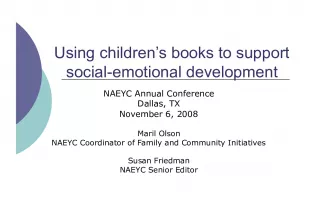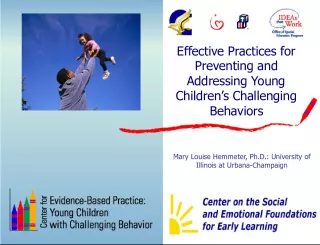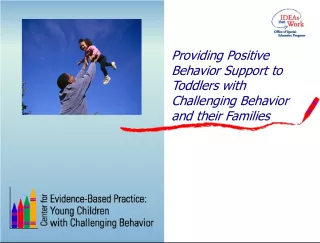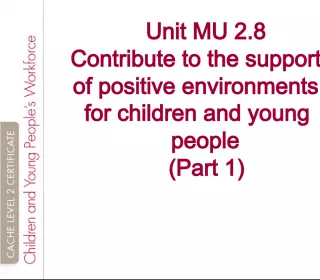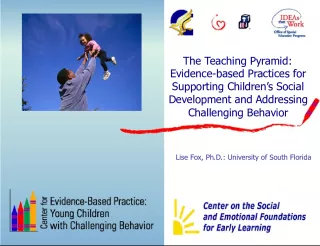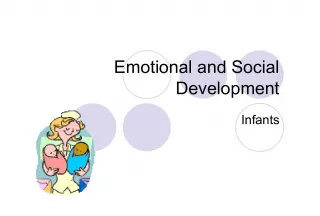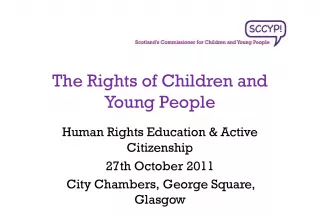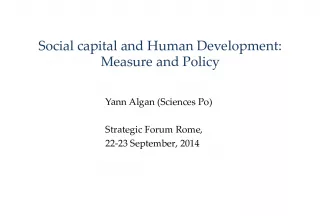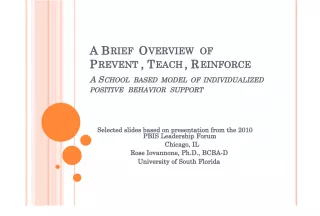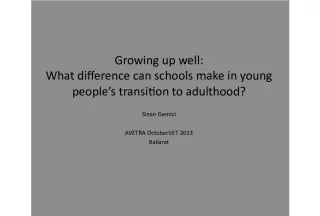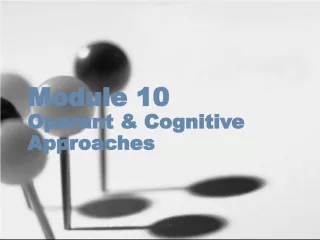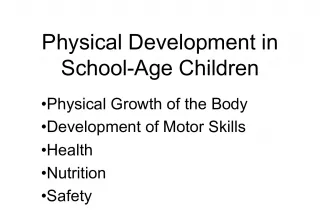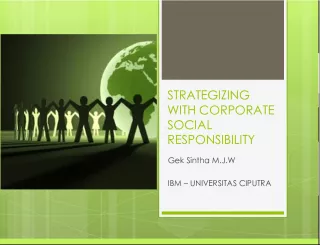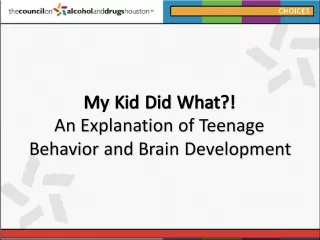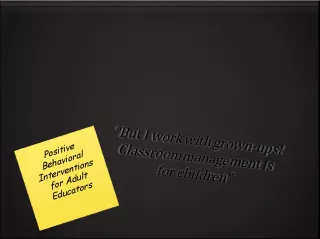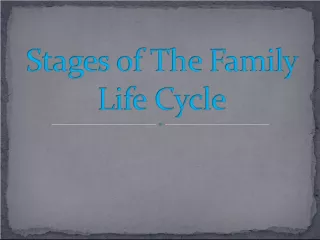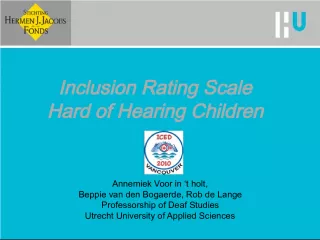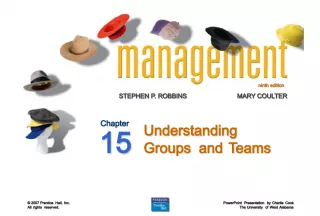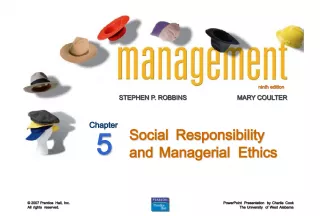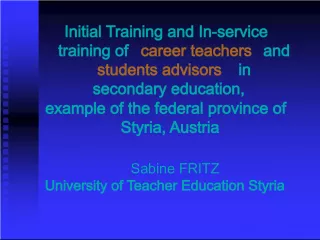Social and Emotional Development in Young Children through Positive Behavior Supports


This article examines how positive behavior supports can foster social and emotional development in young children, and the impact of teachers on learning through interactions. It also explores the challenges in educating children with delays in social, emotional and behavioral development, and how early appearing behavioral problems can predict negative outcomes later in life.
- Uploaded on | 0 Views
-
 stefani
stefani
About Social and Emotional Development in Young Children through Positive Behavior Supports
PowerPoint presentation about 'Social and Emotional Development in Young Children through Positive Behavior Supports'. This presentation describes the topic on This article examines how positive behavior supports can foster social and emotional development in young children, and the impact of teachers on learning through interactions. It also explores the challenges in educating children with delays in social, emotional and behavioral development, and how early appearing behavioral problems can predict negative outcomes later in life.. The key topics included in this slideshow are social development, emotional development, positive behavior supports, teacher impact, early childhood education,. Download this presentation absolutely free.
Presentation Transcript
1. Social and Emotional Development for Young Children Using Positive Behavior Supports Heather Davis, M.Ed. Texas A&M University August 19 th 2014 Adapted from: Hemmeter, M. L., & Fox, L. (2009). The Teaching Pyramid: A model for the implementation of classroom practices within a program-wide approach to behavior support. NHSA Dialogue, 12 (2), 133-147.
2. How Teachers Impact Learning Interactions between a teacher and a child foster social, behavioral, and cognitive development in the early years of schooling and many years later (Hamre, Hatfield, Pianta, & Jamil, 2014) Delays in social-emotional and behavioral development for children entering early childhood settings are reported by teachers as one of the greatest challenges in educating young children (Whitted, 2014) Children who are unsuccessful at meeting classroom behavioral expectations early on often face rejection from both their peers and teachers ( Chang, 2003; Coie & Dodge, 1998) The Center for Evidence-Based Practice (2004) stated, Early appearing behavioral problems during a childs preschool years are the single best predictors of school dropout, delinquency, gang membership, and adult incarceration (p. 1).
3. Understanding Social & Emotional Development for Young Children Hemmeter, M. L., & Fox, L. (2009). The Teaching Pyramid: A model for the implementation of classroom practices within a program-wide approach to behavior support. NHSA Dialogue, 12 (2), 133-147.
4. The Goal of the Pyramid is to Promote Children s Success By: Creating an environment where EVERY child feels good about coming to school. Designing an environment that promotes child engagement. Focusing on teaching children what TO DO! Teach expectations and routines. Teach skills that children can use in place of challenging behaviors .
5. Key Social Emotional Skills Children Need as They Enter School Confidence Capacity to develop good relationships with peers and adults Concentration and persistence on challenging tasks Ability to effectively communicate emotions Ability to listen to instructions and be attentive Ability to solve social problems What do children do when they dont have each of these skills?
6. Building Relationships Why is it important? The relationships that we build with children, families, and colleagues are at the foundation of everything we do. It is important to build these relationships early on rather than waiting until there is a problem. Children learn and develop in the context of relationships that are responsive, consistent, and nurturing.
7. Building Relationships Helps each child feel accepted in the group Assists children in learning to communicate and get along with others Encourages feelings of empathy and mutual respect among children and adults Provides a supportive environment in which children can learn and practice appropriate and acceptable behaviors as individuals and as a group
8. Examining Attitudes about Challenging Behaviors W h a t b e h a v i o r s p u s h y o u r b u t t o n ? H o w d o t h e s e b e h a v i o r s m a k e y o u f e e l ? W h a t i s y o u r r e s p o n s e w h e n t h e s e b e h a v i o r s o c c u r ? H o w d o e s t h i s i m p a c t y o u r r e l a t i o n s h i p w i t h a c h i l d a n d h i s / h e r f a m i l y ?
9. Reframing Activity In pairs or in small groups: Read the four examples listed. Have participants take each of their hot buttons, reread it, and consider how they can reframe the behavior. In reframing the challenging behaviors, do not come up with solutions but rather restate the behaviors to make them more manageable. Be prepared to share your ideas with the large group.
10. Teach Me What to Do Instead Friendship skills Following rules, routines and directions Identifying feelings in self and others Controlling anger and impulse Problem solving
11. Building Positive Relationships by Making Deposits Maintain a 5:1 (positive to negative) Give attention when the child is engaged in appropriate behaviors
12. It All Adds Up Deposits: Active Listening Wait Time Observation Mirroring Self Talk Parallel Talk Reflection Expansion Modeling Withdrawals : No Don t Stop Demands - directions Using a loud voice Intimidating request
13. Every child needs one person who is crazy about him. - Uri Bronfenbrenner
14. High Quality Supportive Environments Hemmeter, M. L., & Fox, L. (2009). The Teaching Pyramid: A model for the implementation of classroom practices within a program-wide approach to behavior support. NHSA Dialogue, 12 (2), 133-147.
15. High Quality Supportive Environments Engagement for Every Child Universal Design for Learning Making Accommodations, Providing Support
16. Classroom Arrangement and Environmental Supports Physical Design Environmental Cues Schedules and Routines Transitions Promoting Engagement During Large and Small Group Activities Simple Rules/Expectations Ongoing Monitoring and Positive Attention
17. What is This Environment Telling Children to Do? Physical Design Environmental Cues Transitions
18. Providing Choices Schedules & Routines
19. Simple Expectations
20. Teaching New Skills: Stages of Learning Show and Tell Acquisition: new skill or concept Practice Makes Perfect Fluency: the ability to immediately use the skill or concept without a prompt You Got It! Maintenance: continuing to use the skill or concept over time Generalization: applying the skill or concept to new situations, people, activities, ideas, and settings
21. Promoting the Social Development of All Children Teach the whole class Circle time Centers Small group activities Partnering with families Target the individual skill instruction needs of each child Embedded instruction Prompting and priming (ounce of prevention) Partnering with families
22. Learning About Our Feelings Recognizing and relating with others feelings Recognize anger in oneself and others Understanding appropriate ways to express anger Learning how to calm down Recognizing our feelings and using self- regulation
23. Feelings
24. Teachers and children can check in each morning by choosing a feeling face that best describes their affective state and putting it next to their name. Children can be encouraged to change their feeling faces throughout the day as their feelings change. Checking In
25. Turtle Technique Recognize that you feel angry. Think Stop. Go into shell. Take 3 deep breaths. And think calm, coping thoughts. Come out of shell when calm and think of a solution.
26. Problem Solving Steps Would it be safe? Would it be fair? How would everyone feel?
27. Help the Child Think of a Possible Solution: Get an adult Ask nicely Ignore Play Say, Please stop. Say, Please. Share Trade toys/item Wait and take turns Get an Adult
28. When Children Lack Key Social Emotional Skills Structure a supportive learning environment Make deposits with positive reinforcement and praise Individually teach children who are missing social emotional skills Target the skills that are most important Increase learning opportunities to teach and practice
29. Questions and Thank You! Heather Davis hsdavis@tamu.edu
